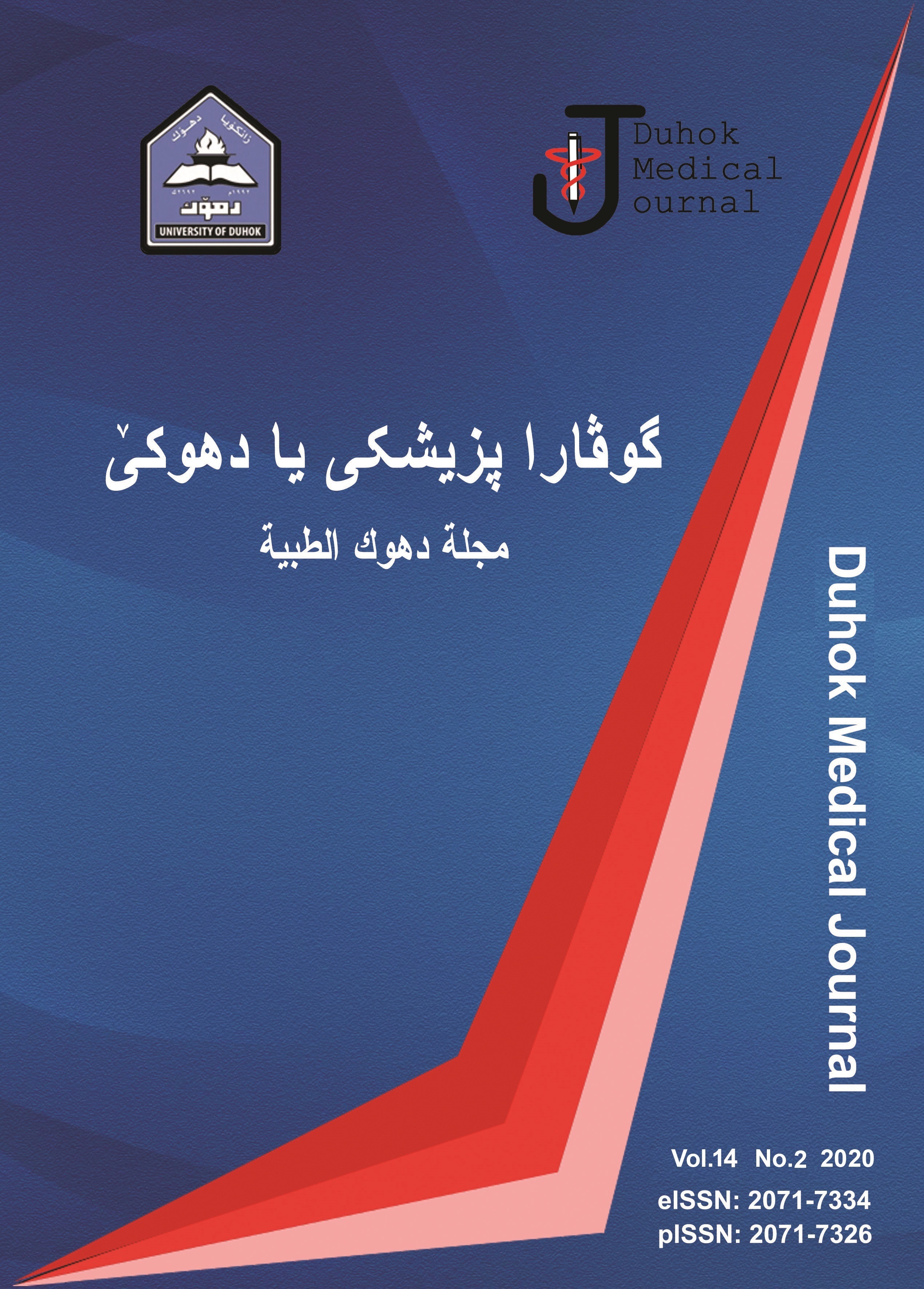VALUES OF SERUM C-REACTIVE PROTEIN AND SALIVARY IMMUNOGLOBULIN IGA IN DIABETIC PATIENTS: RELATION TO THE SEVERITY OF PERIODONTAL DISEASE
Abstract
https://doi.org/10.31386/dmj.2020.14.2.5
Background: Altered immune response and improper neutrophils chemotaxis, phagocytosis, and adhesion might be the principal causative factor for increased susceptibility to periodontal pathogens and oral complications in diabetic patients. This study aimed to determine the relationship between C-reactive protein and salivary IgA with periodontal disease and the severity of dental caries with the glycemic control state of patients with diabetes mellitus.
Patients and Methods: This study was carried out on 91 subjects, 61 patients with diabetes mellitus, and 30 apparently healthy subjects (as a control group). The patient groups were regularly attended Duhok Diabetes Center, Duhok City, Kurdistan Region (Iraq) for diabetes management. The healthy controls were recruited from the staff and sub staff of Azadi Teaching Hospital. Fasting plasma glucose, HbA1c, and serum high sensitivity C-reactive protein (Hs-CRP) were measured. The whole saliva collection was performed by an unstimulated method for five minutes in a graduated test tube to recognize the salivary secretion rate and then stored at -20 0C for IgA estimation. Periodontal Index was used to determine the periodontal disease status. Each tooth was scored according to the condition of the surrounding tissues.
Results: Significantly higher Hs-CRP (9.2 vs 3.3 µg/ml), fasting plasma glucose (215.4 vs 98.9 mg/dl) and HbA1c (8.5 vs 4.9 %), (P < 0.001 for all parameters, together with lower hemoglobin (13.6 vs 14.5 gm/dl, P=0.03) levels were found in diabetic patients compared to control group, A significantly higher mean salivary IgA level in diabetic patients compared to controls (312.4 vs 177.3 mg/dl, P<0.001), associated with a significant high periodontal index (1.68 vs 0.81, P = 0.003).
Conclusion: Elevated serum Hs-CRP and salivary IgA in patients with diabetes mellitus as inflammatory response sequences raise inflammation potential in the periodontium. Further, the results confirm that periodontal index was associated with poor glycemic control.
Downloads
References
2. Bhuyan SK, Mody RN, Bhuyan R. Estimation and comparison of serum 9and salivary IgA level in controlled, uncontrolled Diabetics and normal individuals. J Ind. Acad. of Oral Med. and Rad. 2011; 23(4): 548-553.
3. Genco RJ , Williams RC. Periodontal Disease and Overall Health: A Clinician’s Guide Overview of Periodontal Disease, 1st Edit. Yardley, USA. 2010; 5-23. ISBN-13: 978-0-6152-8508-5.
4. Taylor GW, Borgnakke WS, Graves DT. Periodontal disease: associations with diabetes, glycemic control and complications, Oral diseases. 2008; 14(3): 191-203, https://doi.org /10.1111/j.1601-0825.2008.01442.
5. Bakianian VP, Vahedi M, Mortazavi H, Abdollahzadeh Sh, Hajilooi M. Evaluation of salivary glucose, IgA and flow rate in diabetic patients: a case-control study. J Dent. (Tehran) 2010; 7(1): 13-18.
6. Navalkar A, Bhoweer A. Alterations in whole saliva constituents in patients with Diabetes Mellitus and Periodontal Disease. J Indian Academy of Oral Medicine and Radiology. 2011; 23(4): 498-501.
7. Kakoei S, Hosseini B, Haghdoost AA, Sanjari M, Gholamhosseinian A, Afshar VF. Evaluation of salivary secretory immunoglobulin a levels in diabetic patients and association with Oral and dental manifestations. Sultan Qaboos Univ Med J. 2015; 15(4): 507–11.doi: 10.18295/squmj.2015.15.04.011
8. Mehrotra R, Kalontar-Zadeh K, Alder S. Assessment of glycemic control in dialysis patients with diabetes: glycosylated hemoglobin or glycated albumin. Clin J Am Soc Nephrol. 2011; 6 (7): 1520-1522.
9. Jacobson, RH. Factors in selecting serum samples for use in determining the positive/negative threshold (CUT-OFF) in ELISA. Chem. 29, 1998 561-77.
10. Yadav K, Prakash S. Dental Caries: A Microbiological Approach. J Clin Infect Dis Pract. 2017 (2)118. doi: 10.4172/2476-213X.1000118
11. de Almeida Pdel V, Grégio AM, Machado MA, de Lima AA, Azevedo LR. Saliva composition and functions: A comprehensive review.J Contemp Dent Pract. 2008; 9(3): 72-80.
12. Irfan UM, Dawson DV, Bissada NF. Epidemiology of periodontal disease: a review and clinical perspectives. J Int Acad Periodontol. 2001 Jan; 3(1): 14-21.
13. World Health Organization (WHO). Oral health surveys basic methods. 1997 4th edition. World Health Organization. Geneva. Switzerland.
14. Shahrabi M, Nikfarjam J, Alikhani A, Akhoundi N, Ashtiani M, Seraj B. A comparison of salivary calcium, phosphate and alkaline phosphatase in children with severe, moderate caries, and caries free in Tehran’s kindergartens. J Indian Soc Pedod Prev Dent. 2008 Jun; 26(2): 74-77. doi: 10.4103/0970-4388.41621.
15. Bhagwat R, Gupte A, Yadav KS. Diagnostic utility of hs-CRP in coronary heart disease. Int J Mol Biol. 2012; 3(1): 36-39.
16. Bültzingslöwen V, Sollecito TP, Fox PC, Daniels T, Jonsson R, Lockhart PB et al. Salivary dysfunction associated with systemic diseases: systematic review and clinical management recommendations. Oral Surg Oral Pathol Oral Radiol Endod. 2007 Mar; 103 Suppl: S57.e1-15. doi: 10.1016/ j.tripleo.
17. Panchbhai AS, Degwekar SS, Bhowte RR. Estimation of salivary glucose, salivary amylase, salivary total protein and salivary flow rate in diabetics in India. J oral sci. 2010; 52 (3): 359-368.
18. Al-Zahawi SM, Al-Barzenji HAM, Al-Qassab ZA. Effects of diabetes mellitus type II on salivary flow some salivary parameters (total protein, glucose, and amylase) in Erbil City. J Bagh College Dentistry. 2012; 24 (2): 123-127.
19. Harrison R and Bowen WH Flow rate and organic constituents of whole saliva in insulin – dependent diabetic children and adolescents. Pediatric Dentistry. 1987; 9(4): 287-291
20. Al-Maroof RH. Alteration of saliva in insulin dependent diabetic patients and its relation to their periodontal status. Al-Rafidain Dent J. 2010; 10 (1): 102-109.
21. BranchoL-de-Almeida LS, Alves CMC, Lopes FF, Pereira AFV, Guerra RNM, Pereira ALA Salivary IgA and periodontal treatment need in diabetic patients. Braz Oral Res. 2011; 25 (6), 550-555.
22. Sardari F, Tahmasbi A, Ghanbarzadegan A. Salivary IgA concentration in diabetic patients compared to healthy controls. Dental hypotheses. 2015; (6)2, 60-64 DOI: 10.4103/2155-8213.158478
23. Al-Rawi N, El-Samarrai S. Salivary and serum immune system in relation to carries-experience among type 1 insulin–dependent diabetic children. J Bagh College Dentistry. 2010; 22 (2): 108-112.






